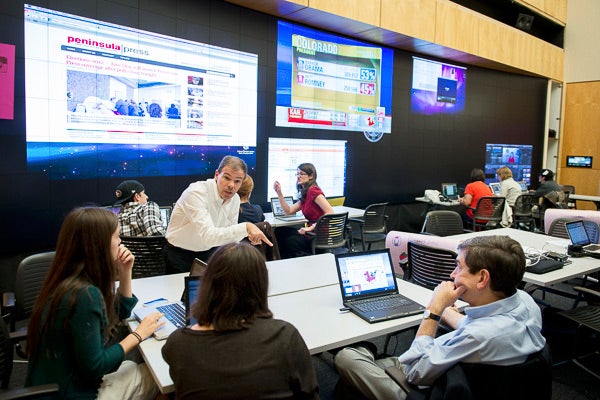|
November 7, 2012
Stanford student journalists cover election from political command center
From the high-tech, information-inundated Wallenberg Learning Theater, Stanford journalism students covered the election for the Peninsula Press and KQED News. By Max McClure

Lecturer R.B. Brenner, center, talks with student journalists and visiting professor Joel Brinkley on election night. (Photo: Linda Cicero/Stanford News Service)
The students were hunched over laptops, watching the election results for California's Proposition 37, "Mandatory Labeling of Genetically Engineered Food." At the moment, only 29 percent of precincts were reporting – and the students couldn't make a move until it jumped above 30 percent. In front of them, an enormous wall of screens displayed competing news channels, websites and computer desktops.
And then: "30.9 percent," said Caroline Davis, enrolled in Stanford's graduate journalism program. Fellow student Melissa Pandika and communication lecturer Thomas Hayden immediately began typing the latest returns into their article.
Within minutes, the piece flashed up on the wall, on the front page of the Stanford journalism program's Peninsula Press.
"This feels more like a newsroom than anything else we've done," Pandika said.
Election command
Nothing says election night like a wall covered in frantically updating newsfeeds. And the Stanford journalism program had the opportunity to witness Obama's re-election last night from its very own frenetic political data command center.
The event, held in Wallenberg Hall's thoroughly wired Learning Theater, was the brainchild of Ann Grimes, the director of the Graduate Program in Journalism, and communication lecturer R. B. Brenner.
The room's back wall is an enormous high-resolution screen capable of handling 16 inputs at any one time. As Bob Smith, director of technologies for Wallenberg Hall, put it, "Behind this is the same stuff as is in NASA Mission Control."
Mission Control was an apt description. Tightly coordinated groups of students packed the room, from both Brenner's graduate Public Issues Reporting class and the undergraduate introductory journalism course Reporting, Writing, and Understanding the News.
Each hot-button proposition, measure or local race was covered by a team of students overseen by a faculty editor. Other teams covered other areas of interest – social media, or a multimedia look at why local citizens had shown up to vote.
Working in real time
Members of Stanford's journalism program had been covering aspects of the election before Tuesday. And the Proposition 37 article, for instance, was largely written in advance: the students had spent the previous weeks conducting background research, talking to the Yes and No campaigns, even interviewing people at farmers markets and grocery stores.
But reporting on election night itself ramped up the program's intensity to a new level – especially because stories that are initially posted on the Press frequently end up on the websites of media partners KQED and the San Francisco Chronicle.
Brenner and Grimes, both veterans of the Washington Post political newsroom, said they modeled the room after election night coverage in the District of Columbia.
"It's an opportunity for the students to work in real time and in as realistic a setting as possible," Brenner said. "And the Peninsula Press is very competitive – we're looking to scoop the Mercury [San Jose Mercury News] and the Chronicle."
The students were focused enough on their work that the election itself was almost an afterthought. Graduate student Xandra Clark spent most of the evening editing audio and video for the Press' multimedia piece. How did people react when an Obama victory was announced?
"They didn't," she said. "I didn't even notice at first."
-30-
|